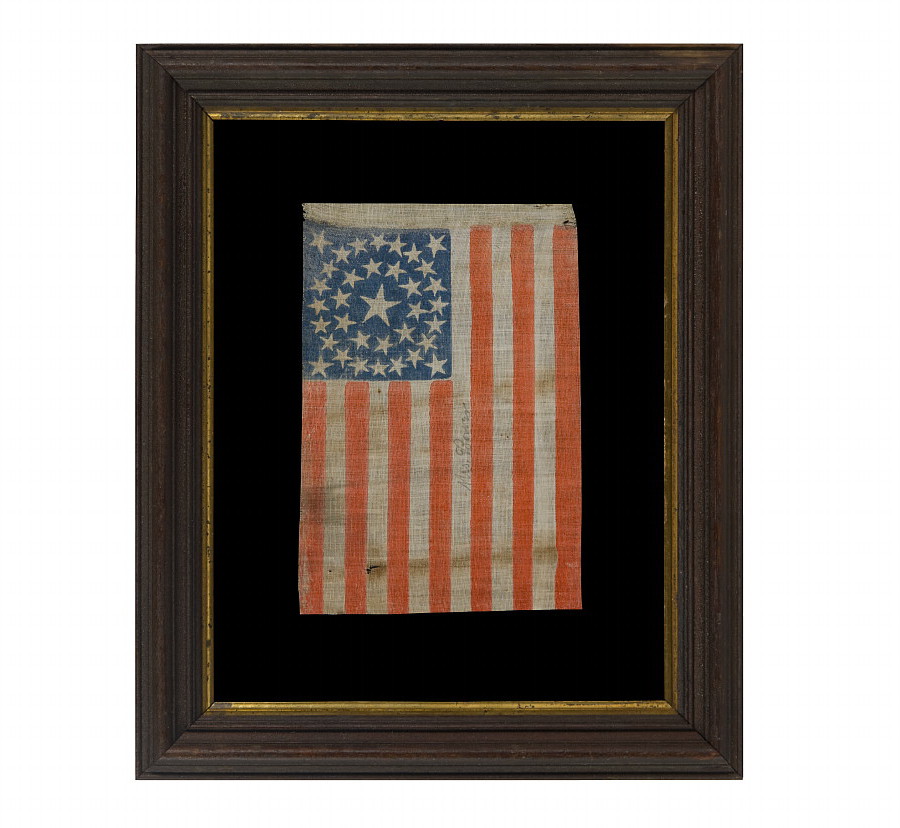
| |
35 WHIMSICALLY SHAPED STARS IN A DOUBLE-WREATH PATTERN, CIVIL WAR PERIOD, 1863-65, WEST VIRGINIA STATEHOOD, A VERY RARE VARIETY, SIGNED "MRS. BOWER" OR "BOWEN" |
|
| Available: |
Sold |
| Frame Size (H x L): |
13.75" x 17.75" |
| Flag Size (H x L): |
6.25" x 9.25" |
|
| Description....: |
|
35 WHIMSICALLY SHAPED STARS IN A DOUBLE-WREATH PATTERN, CIVIL WAR PERIOD, 1863-65, WEST VIRGINIA STATEHOOD, A VERY RARE VARIETY, SIGNED "MRS. BOWER" OR "BOWEN":
35 star American national parade flag of the Civil War period, printed on coarse, glazed cotton. Note the beautiful medallion star configuration, which consists of two wreaths of stars, surrounding a large center star, and a flanking star in each corner of the blue canton. Note how the stars of this particular variety have unusually elongated arms, which adds a nice degree of folk quality to the design. Traits like this add visual impact and are desired by flag collectors.
Though the name of the company that made this flag remains unknown, I have identified between three and four other star counts that were almost certainly produced by the same maker. Parade flags that have stars with the same, unusual shape also exist with star counts of 29, 33, and 34, as well as three other styles. These include 13 star examples made to represent the original 13 colonies, 15 star examples that may reflect Kentucky statehood, and 7 star, Confederate sympathizer flags that represent the initial wave of 7 states to secede from the Union. All of these flags appear in the same general era and are likely from the same manufacturer. Of the seven different star counts, it is interesting to note that the 35 star flags are among the most rare; I know of 10 or fewer to exist. In addition, the flags in the 35 star variety are slightly more square in shape than their counterparts in other star counts, and their center stars are proportionally larger, both of which are factors that influence collectability.
The name "Mrs. Bower" or "Mrs. Bowen" is written on the reverse in pencil in the stripes. This would indicate the name of a former owner. It was common to mark flags like this during the 19th century, but because such writing isn't present on most flags, and because it adds some associated history, the existence of a name or other written information is very desirable among flag collectors and enthusiasts.
West Virginia was admitted into the Union as the 35th State on June 20th, 1863, and this flag was used during the closing years of the Civil War. Although 35 was the official star count until July 4th, 1865, most flag makers would have added a 36th star after the addition of Nevada on October 31st, 1864. This means that 35 star flags were realistically produced for less than a year and a half. Further, they are significantly more scarce than 34 and 36 star examples.
It is interesting to note that this flag was found in Southern Ohio with a handful of others of its kind, along with 15 star examples from the same maker. Southern Ohio borders both West Virginia and Kentucky, the two states which these flags reflect. It's actually unusual to find flags with star counts specific to a state, within that exact state. Though certainly inconclusive, the discovery of these two styles in a nearby, bordering state, does suggests some geographical relationship, maybe not of manufacture, but probably of use.
Mounting: The solid walnut molding has a beautiful profile with a convex center and a gilded liner. It dates to the period between 1850 and 1870. The flag has been hand-stitched to 100% cotton, black in color, which has been washed to reduce excess dye. And acid-free agent was added to the wash to further set the dye and the fabric was heat-treated for the same purpose. Spacers keep the textile away from the glass, which is U.V. protective.
Condition: There is minor to moderate foxing, staining, and fading throughout, accompanied by minor fabric loss. Many collectors prefer early flags to show their age and history of use. Further, this is a rare example, which warrants most condition issues.
Please Note: Don't be fooled by the seemingly backwards orientation. It wasn't until the period between roughly 1890 and 1900 that the flag ethics we have today began to emerge. During the Civil War, there wasn't exactly a backwards or forwards like there is today. Parade flags are printed on one side only and the color bleeds through to the other side. Sometimes the obverse is stronger and sometimes the reverse is stronger in color. When the reverse is stronger, that is the side I show when I frame a flag. When the reverse is stronger, typically I would hang the flag vertically, with the canton in the upper left. By modern ethics, the canton should always be in the upper left whether the flag is displayed horizontally or vertically. But in the case of this particular parade flag, the name of the former owner is best seen with the flag "backwards-facing", which was perfectly acceptable in the period of the flag's making, so this is the way I am displaying it. However, if you wish to instead hang it so it is draping vertically, there are additional hangers on the reverse which allow that positioning. |
|
|
|
| Collector Level: |
Advanced Collectors and the Person with Everything |
|
| Flag Type: |
Parade flag |
|
| Star Count: |
35 |
|
| Earliest Date of Origin: |
1863 |
|
| Latest Date of Origin: |
1865 |
|
| State/Affiliation: |
West Virginia |
|
| War Association: |
1861-1865 Civil War |
|
| Price: |
SOLD |
|
| |
Views: 2910 |
|
|
|

